Analysis of the Spatio-Temporal Patterns of Dry and Wet Conditions in Central Asia
Abstract
:1. Introduction
2. Materials and Methods
2.1. Study Area
2.2. Data Collection and Preparation
2.3. Calculation of the SPEI
2.4. Statistical Method
2.4.1. Mann-Kendall Test
2.4.2. Empirical Orthogonal Function Analysis
2.4.3. Drought Frequency
3. Results
3.1. Time Distribution Features of SPEI
3.1.1. Annual Variation Characteristics of SPEI
3.1.2. Seasonal Variation Characteristics of SPEI
3.2. Spatial Distribution Characteristics of SPEI in Central Asia
3.2.1. Interannual Variation Characteristics of SPEI in Central Asia
3.2.2. Seasonal Variation Characteristics of SPEI in Central Asia
3.3. Frequency of Drought Events
4. Discussion and Conclusions
Acknowledgments
Author Contributions
Conflicts of Interest
References
- Lobell, D.B.; Roberts, M.J.; Schlenker, W.; Braun, N.; Little, B.B.; Rejesus, R.M.; Hammer, G.L. Greater sensitivity to drought accompanies maize yield increase in the US Midwest. Science 2014, 344, 516–519. [Google Scholar] [CrossRef] [PubMed]
- Piao, S.L.; Ciais, P.; Huang, Y.; Shen, Z.H.; Peng, S.S.; Li, J.S.; Zhou, L.P.; Liu, H.Y.; Ma, Y.C.; Ding, Y.H.; et al. The impacts of climate change on water resources and agriculture in China. Nature 2010, 467, 43–51. [Google Scholar] [CrossRef] [PubMed]
- Mirabbasi, R.; Fakheri-Fard, A.; Dinpashoh, Y. Bivariate drought frequency analysis using the copula method. Theor. Appl. Climatol. 2012, 108, 191–206. [Google Scholar] [CrossRef]
- Huang, S.; Chang, J.; Huang, Q.; Chen, Y. Spatio-temporal changes and frequency analysis of drought in the wei river basin, China. Water Resour. Manag. 2014, 28, 3095–3110. [Google Scholar] [CrossRef]
- Shiau, J.T.; Modarres, R. Copula-based drought severity-duration-frequency analysis in Iran. Meteorol. Appl. 2009, 16, 481–489. [Google Scholar] [CrossRef]
- Tao, H.; Borth, H.; Fraedrich, K.; Schneidereit, A.; Zhu, X. Hydrological extremes in the Aksu-tarim river basin: Mid-latitude dynamics. Clim. Dyn. 2015, 46, 2039–2050. [Google Scholar]
- Ionita, M.; Scholz, P.; Chelcea, S. Spatio-temporal variability of dryness/wetness in the Danube river basin. Hydrol. Processes 2015, 29, 4483–4497. [Google Scholar] [CrossRef]
- Liu, Z.; Wang, Y.; Shao, M.; Jia, X.; Li, X. Spatiotemporal analysis of multiscalar drought characteristics across the loess plateau of China. J. Hydrol. 2016, 534, 281–299. [Google Scholar] [CrossRef]
- Zhai, J.; Su, B.; Krysanova, V.; Vetter, T.; Gao, C.; Jiang, T. Spatial variation and trends in PDSI and SPI indices and their relation to Streamflow in 10 large regions of China. J. Clim. 2010, 23, 649–663. [Google Scholar] [CrossRef]
- Akbar, N.; Ahmad, N.; Ardavan, G. Comparison of the suitability of standardized precipitation index (SPI) and aggregated drought index (ADI) in minab watershed (Hormozgan Province/South of Iran). Afr. J. Agric. Res. 2012, 7, 5905–5911. [Google Scholar] [CrossRef]
- Chub, V.E. Climate Change and Its Impact on the Natural Resources Potential of the Republic of Uzbekistan; Main Administration on Hydrometeorology under the Cabinet of Ministers of the Republic of Uzbekistan: Tashkent, Uzbekistan, 2000. [Google Scholar]
- Hao, Z.; AghaKouchak, A. Multivariate standardized drought index: A parametric multi-index model. Adv. Water Resour. 2013, 57, 12–18. [Google Scholar] [CrossRef]
- Rajsekhar, D.; Singh, V.P.; Mishra, A.K. Multivariate drought index: An information theory based approach for integrated drought assessment. J. Hydrol. 2015, 526, 164–182. [Google Scholar] [CrossRef]
- Tan, C.P.; Yang, J.P.; Li, M. Temporal-spatial variation of drought indicated by spi and spei in ningxia hui autonomous region, China. Atmosphere (Basel) 2015, 6, 1399–1421. [Google Scholar] [CrossRef]
- Shi, B.L.; Zhu, X.Y.; Hu, Y.C.; Yang, Y.Y. Drought characteristics of Henan province in 1961–2013 based on standardized precipitation evapotranspiration index. J. Geogr. Sci. 2017, 27, 311–325. [Google Scholar] [CrossRef]
- Yu, M.; Li, Q.; Hayes, M.J.; Svoboda, M.D.; Heim, R.R. Are droughts becoming more frequent or severe in china based on the standardized precipitation evapotranspiration index: 1951–2010? Int. J. Climatol. 2014, 34, 545–558. [Google Scholar] [CrossRef]
- Vicente-Serrano, S.M.; Beguería, S.; López-Moreno, J.I. Comment on “characteristics and trends in various forms of the palmer drought severity index (pdsi) during 1900–2008” by Aiguo Dai. J. Geophys. Res. 2011, 116. [Google Scholar] [CrossRef]
- Begueria, S.; Vicente-Serrano, S.M.; Reig, F.; Latorre, B. Standardized precipitation evapotranspiration index (spei) revisited: Parameter fitting, evapotranspiration models, tools, datasets and drought monitoring. Int. J. Climatol. 2014, 34, 3001–3023. [Google Scholar] [CrossRef]
- Song, S.; Bai, J. Increasing winter precipitation over arid central Asia under global warming. Atmosphere 2016, 7, 139. [Google Scholar] [CrossRef]
- Yao, J.; Chen, Y. Trend analysis of temperature and precipitation in the Syr Darya basin in Central Asia. Theor. Appl. Climatol. 2014, 120, 521–531. [Google Scholar] [CrossRef]
- Chen, X.; Bai, J.; Li, X.; Luo, G.; Li, J.; Li, B.L. Changes in land use/land cover and ecosystem services in Central Asia during 1990–2009. Curr. Opin. Environ. Sustain. 2013, 5, 116–127. [Google Scholar] [CrossRef]
- Bernauer, T.; Siegfried, T. Climate change and international water conflict in Central Asia. JPR 2012, 49, 227–239. [Google Scholar] [CrossRef]
- Badescu, V.; Cathcart, R.B. Aral sea partial restoration. Ii. Simulation of time-dependent processes. IJEWM 2011, 7, 164–174. [Google Scholar] [CrossRef]
- Hu, Z.Y.; Zhang, C.; Hu, Q.; Tian, H.Q. Temperature changes in central Asia from 1979 to 2011 based on multiple datasets. J. Clim. 2014, 27, 1143–1167. [Google Scholar] [CrossRef]
- The Standardized Precipitation-Evapotranspiration Index. Available online: http://spei.csic.es/ (accessed on 1 December 2016).
- Vicente-Serrano, S.M.; Begueria, S.; Lopez-Moreno, J.I. A multiscalar drought index sensitive to global warming: The standardized precipitation evapotranspiration index. J. Clim. 2010, 23, 1696–1718. [Google Scholar] [CrossRef]
- Charusombat, U.; Niyogi, D. A hydroclimatological assessment of regional drought vulnerability: A case study of indiana droughts. Earth Interact. 2011, 15, 1–65. [Google Scholar] [CrossRef]
- Mitra, S.; Srivastava, P. Spatiotemporal variability of meteorological droughts in Southeastern USA. Nat. Hazards 2017, 86, 1007–1038. [Google Scholar] [CrossRef]
- Mann, H.B. Nonparametric tests against trend. Econometrica 1945, 13, 245–259. [Google Scholar] [CrossRef]
- Tabari, H.; Hosseinzadeh Talaee, P.; Mousavi Nadoushani, S.S.; Willems, P.; Marchetto, A. A survey of temperature and precipitation based aridity indices in Iran. Quat. Int. 2014, 345, 158–166. [Google Scholar] [CrossRef]
- Gocic, M.; Trajkovic, S. Analysis of precipitation and drought data in Serbia over the period 1980–2010. J. Hydrol. 2013, 494, 32–42. [Google Scholar] [CrossRef]
- Chowdhury, R.K.; Beecham, S. Australian rainfall trends and their relation to the southern oscillation index. Hydrol. Processes 2010, 24, 504–514. [Google Scholar] [CrossRef]
- Hamed, K.H. Trend detection in hydrologic data: The Mann-Kendall trend test under the scaling hypothesis. J. Hydrol. 2008, 349, 350–363. [Google Scholar] [CrossRef]
- Xu, C.Y.; Singh, V.P. Evaluation of three complementary relationship evapotranspiration models by water balance approach to estimate actual regional evapotranspiration in different climatic regions. J. Hydrol. 2005, 308, 105–121. [Google Scholar] [CrossRef]
- Hirsch, R.M.; Slack, J.R. A nonparametric trend test for seasonal data with serial dependence. Water Resour. Res. 1984, 20, 727–732. [Google Scholar] [CrossRef]
- Hannachi, A.; Jolliffe, I.T.; Stephenson, D.B. Empirical orthogonal functions and related techniques in atmospheric science: A review. Int. J. Climatol. 2007, 27, 1119–1152. [Google Scholar] [CrossRef]
- Wang, Q.; Wu, J.; Lei, T.; He, B.; Wu, Z.; Liu, M.; Mo, X.; Geng, G.; Li, X.; Zhou, H. Temporal-spatial characteristics of severe drought events and their impact on agriculture on a global scale. Quat. Int. 2014, 349, 10–21. [Google Scholar] [CrossRef]
- Xu, G.; Liu, X.; Wu, G.; Chen, T.; Wang, W.; Zhang, Q.; Zhang, Y.; Zeng, X.; Qin, D.; Sun, W.; et al. Tree ringδ18o’s indication of a shift to a wetter climate since the 1880s in the Western TianShan Mountains of Northwestern China. J. Geophys. Res. Atmos. 2015, 120, 6409–6425. [Google Scholar] [CrossRef]
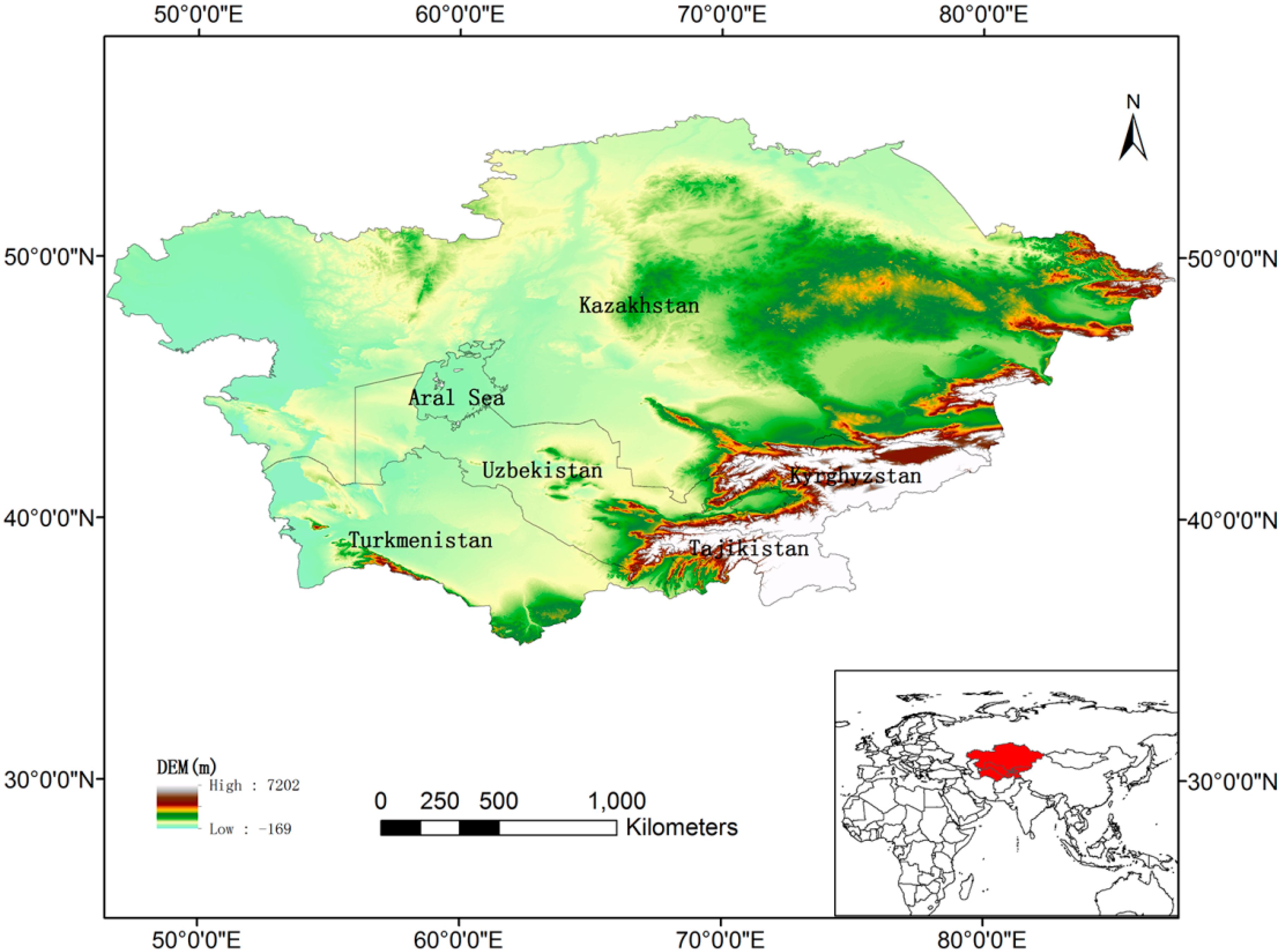
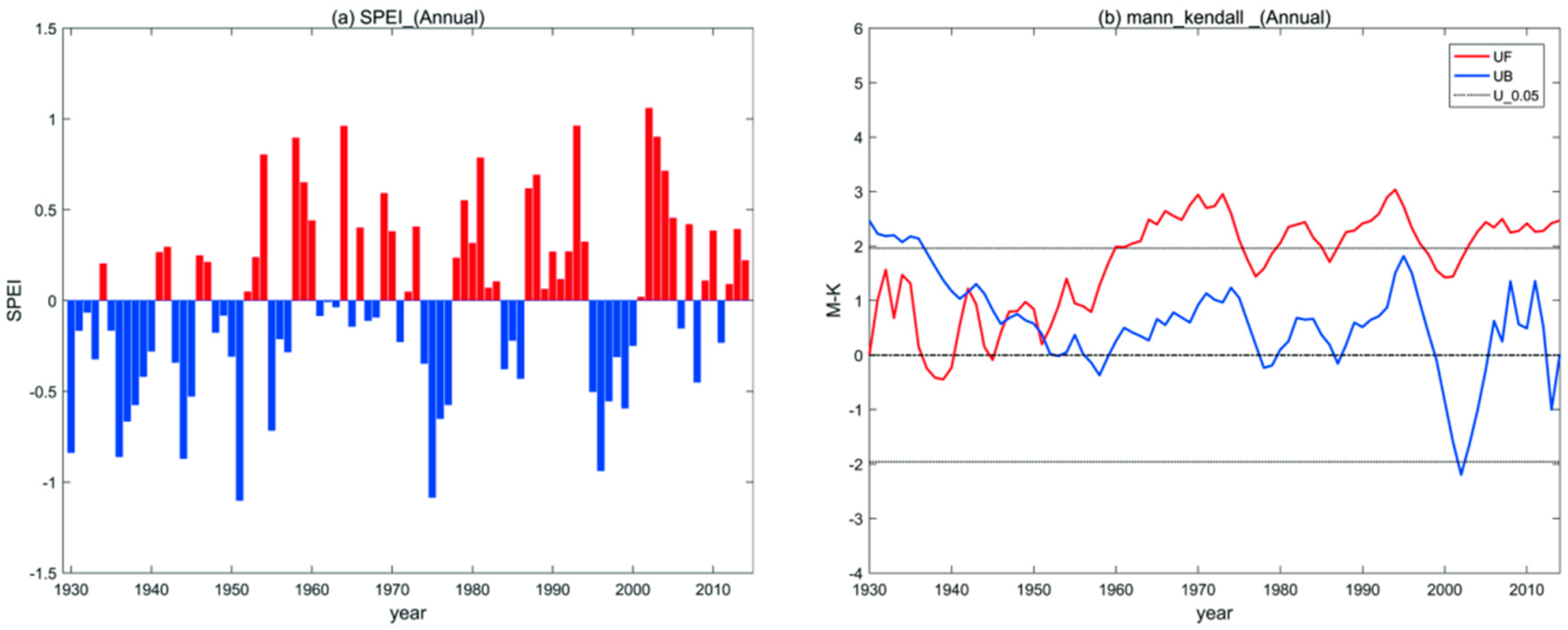
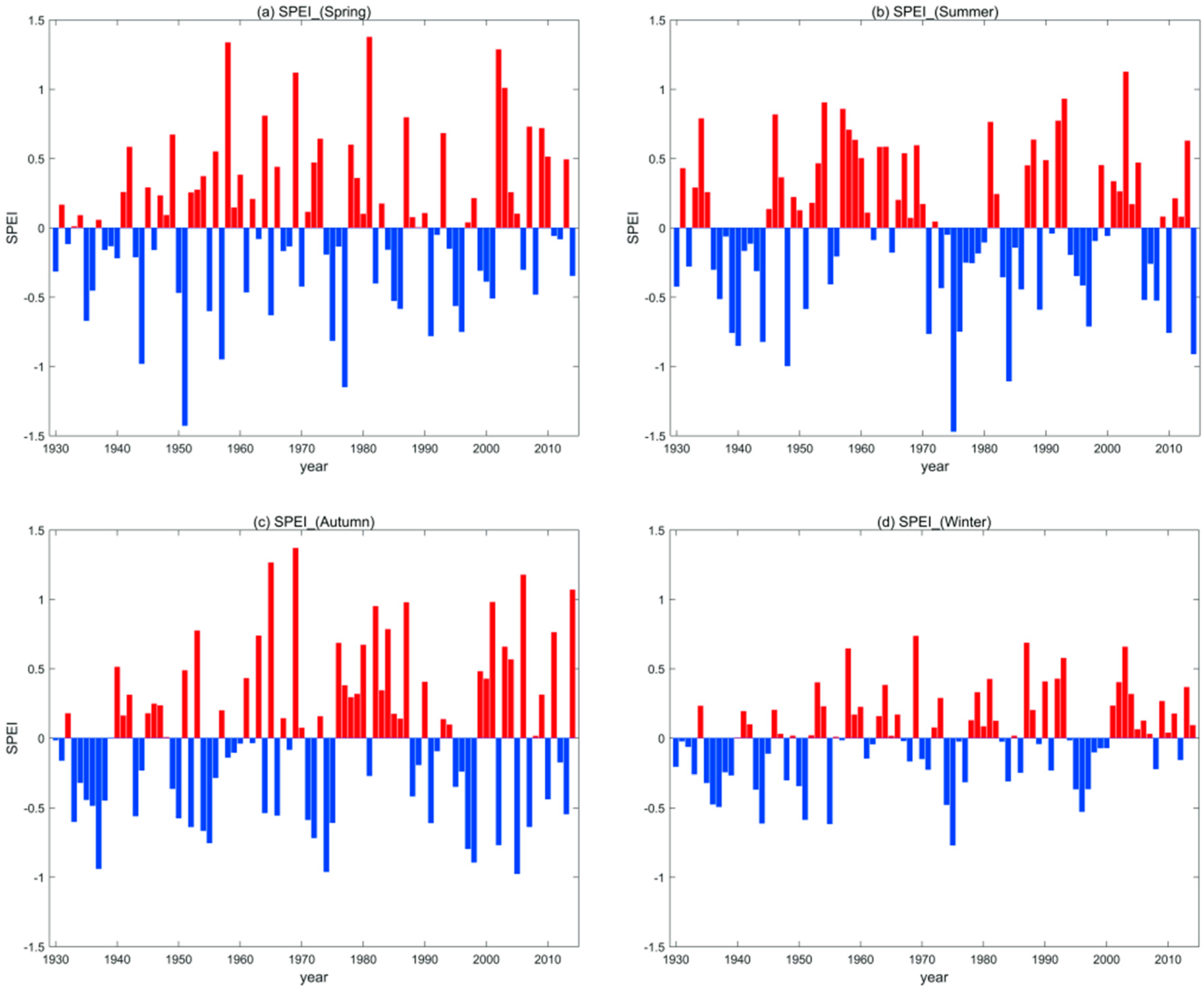

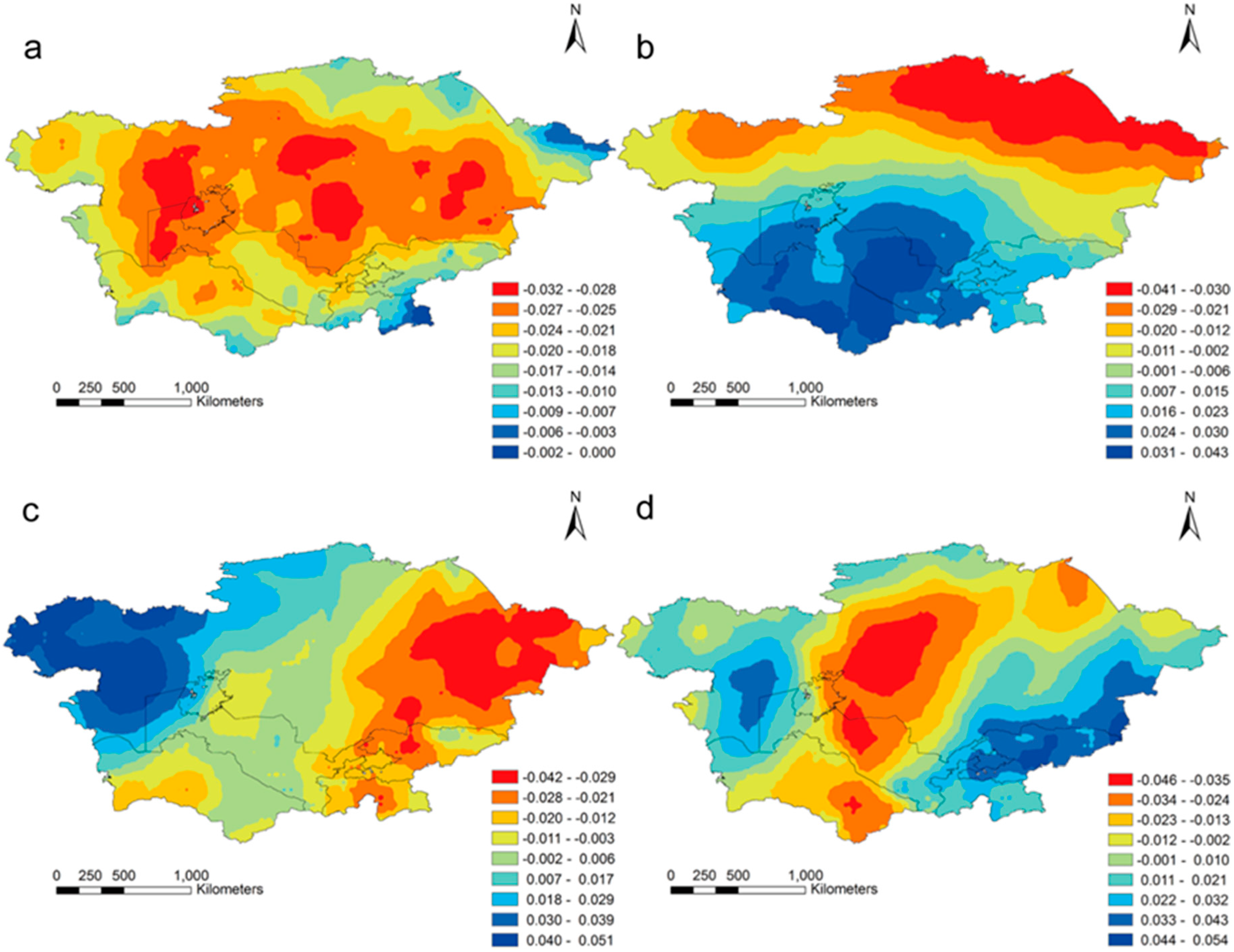
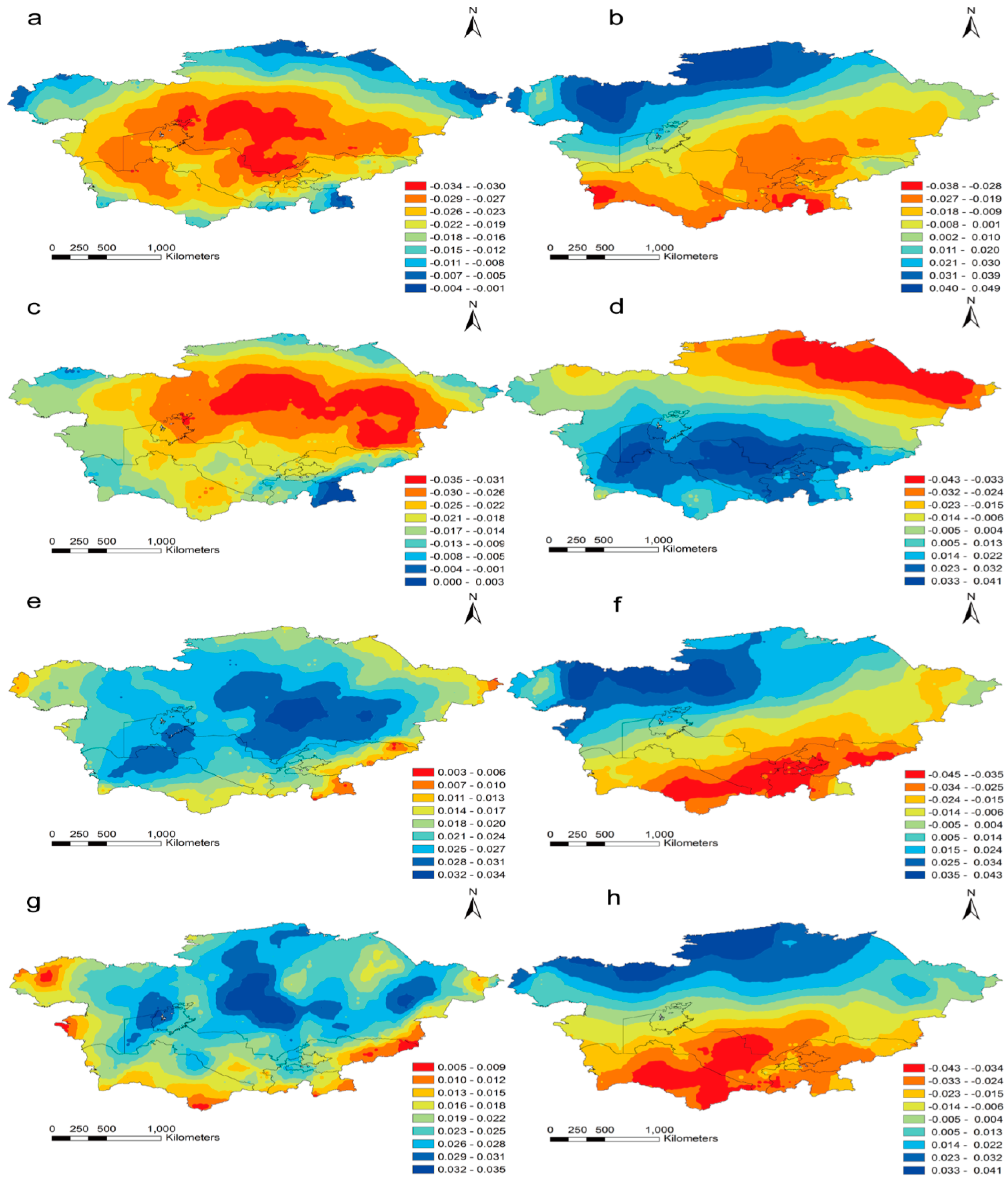
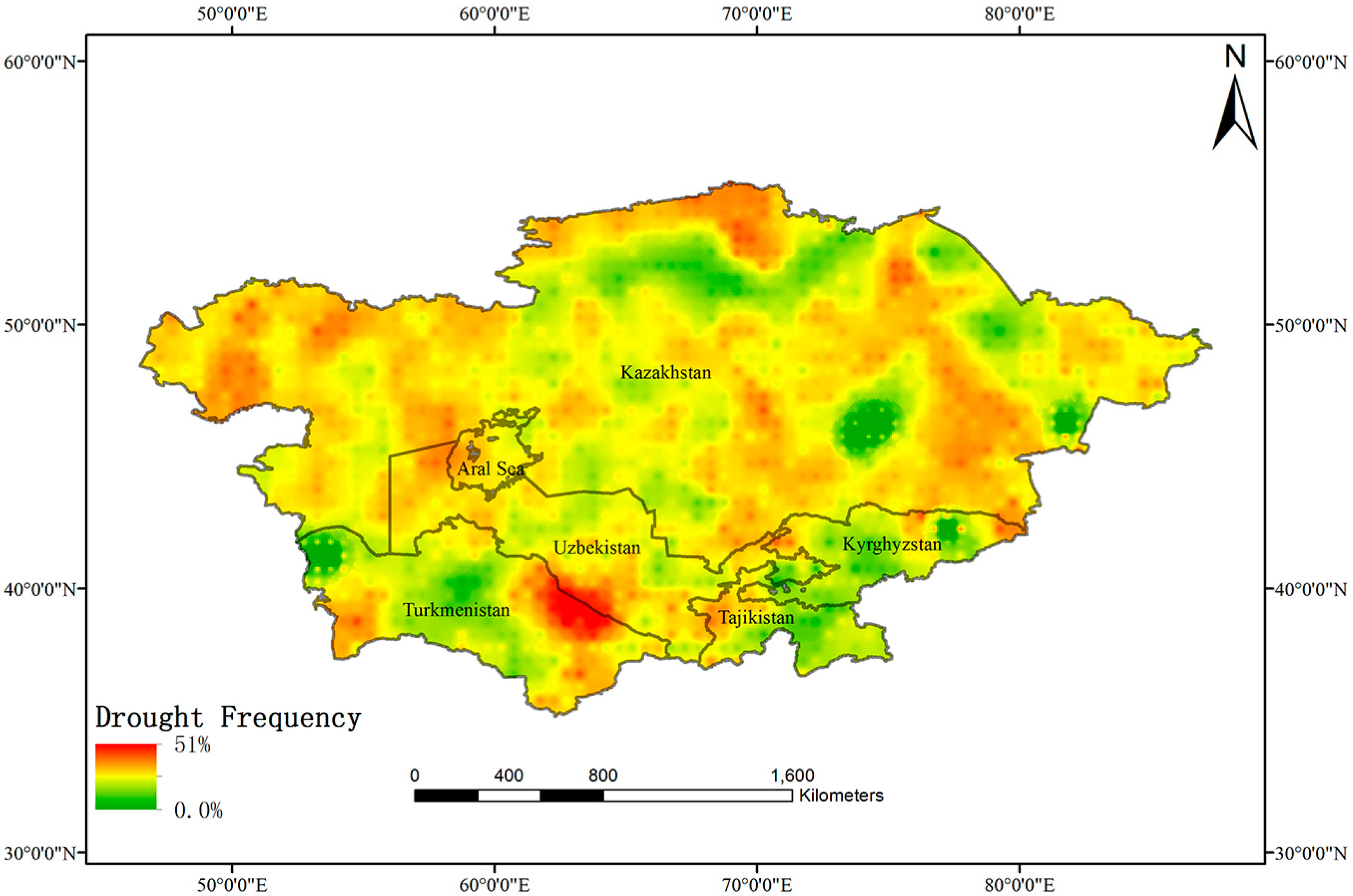
| Categories of Drought | SPEI |
|---|---|
| Extreme drought | SPEI ≤ −2.0 |
| Severe drought | −1.99 < SPEI < −1.5 |
| Moderate drought | −1.49 < SPEI ≤ −1.0 |
| Mild drought | −0.99 < SPEI ≤ −0.5 |
| Non-drought | SPEI ≥ −0 |
© 2018 by the authors. Licensee MDPI, Basel, Switzerland. This article is an open access article distributed under the terms and conditions of the Creative Commons Attribution (CC BY) license (http://creativecommons.org/licenses/by/4.0/).
Share and Cite
Ta, Z.; Yu, R.; Chen, X.; Mu, G.; Guo, Y. Analysis of the Spatio-Temporal Patterns of Dry and Wet Conditions in Central Asia. Atmosphere 2018, 9, 7. https://doi.org/10.3390/atmos9010007
Ta Z, Yu R, Chen X, Mu G, Guo Y. Analysis of the Spatio-Temporal Patterns of Dry and Wet Conditions in Central Asia. Atmosphere. 2018; 9(1):7. https://doi.org/10.3390/atmos9010007
Chicago/Turabian StyleTa, Zhijie, Ruide Yu, Xi Chen, Guijin Mu, and Yanfei Guo. 2018. "Analysis of the Spatio-Temporal Patterns of Dry and Wet Conditions in Central Asia" Atmosphere 9, no. 1: 7. https://doi.org/10.3390/atmos9010007





